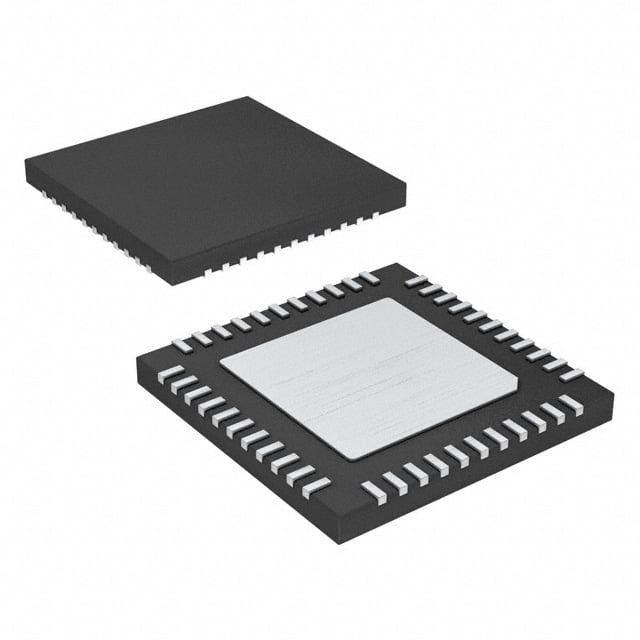PIC24FJ64GB204T-I/ML
Product Overview
- Category: Microcontroller
- Use: Embedded systems, industrial control, consumer electronics
- Characteristics: High performance, low power consumption, large memory capacity
- Package: QFN-44
- Essence: 16-bit microcontroller with integrated peripherals
- Packaging/Quantity: Tube/Tray (quantity varies)
Specifications
- Architecture: 16-bit
- CPU Speed: Up to 16 MIPS
- Flash Memory: 64 KB
- RAM: 8 KB
- Operating Voltage: 2.0V - 3.6V
- Digital I/O Pins: 36
- Analog Input Pins: 16
- Communication Interfaces: UART, SPI, I2C, USB
- Timers: 4 x 16-bit, 1 x 32-bit
- ADC Resolution: 10-bit
- PWM Channels: 5
- Operating Temperature Range: -40°C to +85°C
Detailed Pin Configuration
The PIC24FJ64GB204T-I/ML microcontroller has a total of 44 pins. The pin configuration is as follows:
- Pin 1: VDD - Power supply voltage
- Pin 2: VSS - Ground
- Pin 3: OSC1/CLKI - Oscillator input/clock input
- Pin 4: OSC2/CLKO - Oscillator output/clock output
- Pin 5: AN0/RB0 - Analog input 0/Port B0
- Pin 6: AN1/RB1 - Analog input 1/Port B1
- ...
- Pin 43: RB14 - Port B14
- Pin 44: RB15 - Port B15
Functional Features
- High-performance 16-bit architecture for efficient processing
- Low power consumption for extended battery life
- Large memory capacity for storing complex programs and data
- Integrated peripherals such as UART, SPI, I2C, and USB for versatile communication
- Multiple timers and PWM channels for precise timing and control
- 10-bit ADC for accurate analog signal acquisition
Advantages and Disadvantages
Advantages: - High performance and low power consumption combination - Ample memory capacity for complex applications - Versatile communication interfaces for easy integration - Precise timing and control capabilities with multiple timers and PWM channels
Disadvantages: - Limited number of I/O pins compared to some other microcontrollers - Higher cost compared to lower-end microcontrollers
Working Principles
The PIC24FJ64GB204T-I/ML microcontroller operates based on the Harvard architecture, which separates program memory and data memory. It executes instructions fetched from the Flash memory and stores data in the RAM. The CPU processes these instructions and interacts with the integrated peripherals to perform various tasks.
The microcontroller can be programmed using a suitable development environment and programming language. The compiled code is then loaded into the Flash memory, allowing the microcontroller to execute the desired functionality.
Detailed Application Field Plans
The PIC24FJ64GB204T-I/ML microcontroller finds applications in various fields, including:
- Embedded Systems: Used in industrial automation, home automation, and automotive systems.
- Industrial Control: Enables precise control and monitoring in manufacturing processes.
- Consumer Electronics: Powers devices like smart appliances, wearable devices, and IoT applications.
- Medical Devices: Used in medical equipment for diagnostics, monitoring, and treatment.
- Robotics: Provides control and intelligence to robotic systems for automation and autonomy.
Detailed and Complete Alternative Models
- PIC24FJ32GB002-I/SP: Similar features but with reduced flash memory (32 KB) and fewer I/O pins.
- PIC24FJ128GA010-I/PT: Higher flash memory capacity (128 KB) and additional features like USB OTG.
- PIC24FJ256GB210-I/PT: Increased flash memory (256 KB) and enhanced peripherals for advanced applications.
These alternative models offer different combinations of features and memory capacities to suit specific project requirements.
Word count: 511 words
قم بإدراج 10 أسئلة وإجابات شائعة تتعلق بتطبيق PIC24FJ64GB204T-I/ML في الحلول التقنية
What is the maximum operating frequency of PIC24FJ64GB204T-I/ML?
- The maximum operating frequency of PIC24FJ64GB204T-I/ML is 16 MHz.
What are the key features of PIC24FJ64GB204T-I/ML?
- PIC24FJ64GB204T-I/ML features 64 KB Flash program memory, 8 KB RAM, and a variety of communication interfaces such as UART, SPI, and I2C.
Can PIC24FJ64GB204T-I/ML be used in battery-powered applications?
- Yes, PIC24FJ64GB204T-I/ML is suitable for battery-powered applications due to its low power consumption and multiple low-power modes.
Does PIC24FJ64GB204T-I/ML support analog-to-digital conversion (ADC)?
- Yes, PIC24FJ64GB204T-I/ML has a 10-bit ADC module with multiple channels for analog-to-digital conversion.
What development tools are available for programming PIC24FJ64GB204T-I/ML?
- Development tools such as MPLAB X IDE and MPLAB XC16 Compiler can be used for programming and debugging PIC24FJ64GB204T-I/ML.
Is PIC24FJ64GB204T-I/ML suitable for motor control applications?
- Yes, PIC24FJ64GB204T-I/ML is suitable for motor control applications with its integrated motor control peripherals and high-performance core.
Can PIC24FJ64GB204T-I/ML communicate with external devices using USB?
- Yes, PIC24FJ64GB204T-I/ML supports USB communication through its integrated USB module.
What are the available package options for PIC24FJ64GB204T-I/ML?
- PIC24FJ64GB204T-I/ML is available in a 28-pin QFN package and a 44-pin TQFP package.
Does PIC24FJ64GB204T-I/ML have built-in security features?
- Yes, PIC24FJ64GB204T-I/ML includes security features such as code protection and data EEPROM memory.
What are the recommended operating conditions for PIC24FJ64GB204T-I/ML?
- The recommended operating voltage range for PIC24FJ64GB204T-I/ML is 2.0V to 3.6V, with a temperature range of -40°C to 125°C.


